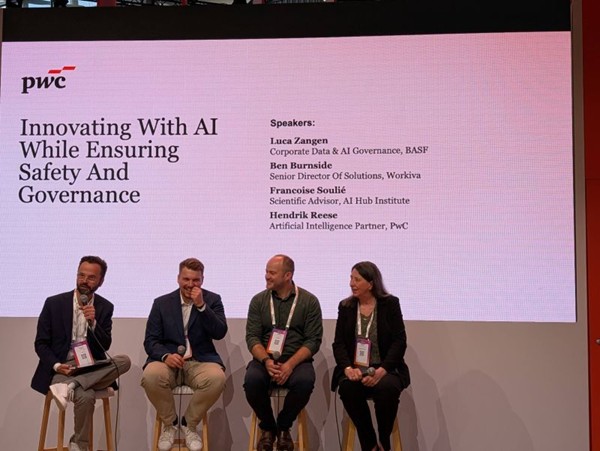If you’re anything like me, you’ve probably noticed we’ve entered this very entertaining phase where everyone (and their grandmother’s dog) has a strong opinion about AI. Some people promise a utopian golden future filled with endless AI-generated efficiencies, others warn us of a tech-driven angry robot apocalypse, while most of us simply wonder whether we’ll soon be replaced by overly enthusiastic and painfully cheap chatbots. Let me cut through the noise : as a CIO who’s seen tech trends come, dazzle, sputter, disappoint, and occasionally deliver, there’s something genuinely groundbreaking about the emergence of agentic AI.
Despite how movie-theater-worthy it sounds, « Agentic AI » isn’t a Bond villain’s latest master plan, though admittedly, it does sound suitably dramatic. Agentic AI represents a significant turning point for how organizations will operate, innovate and grow, potentially even outpacing the excitement of the original AI hype: it’s simply a bigger (and better) deal.
Let’s define it simply. Traditional AI acts like a (very) talented (and all-knowing) assistant: you ask it a question, and it gives you answers. Helpful, good humored, fast… yet essentially reactive. Agentic AI, on the other hand, is proactive. You don’t just ask questions: you assign precise and complex objectives. It then autonomously decides on strategies, outlines necessary tasks, seeks (or builds) resources, and independently takes progressive action toward achieving goals. It acts as a fully autonomous agent: hence the rock’n’roll name.
A quick analogy: traditional GenAI in its most primitive form gives you the recipe; in a more advanced form it follows precise cooking instructions step-by-step. Agentic AI is more like hiring an expert chef who independently plans the menu, shops for ingredients (files the receipts to accounting), prepares dishes, and adapts the recipes along the way, (cleans up the kitchen); always striving toward your ultimate culinary objective.
Sam Altman, CEO of OpenAI, recently outlined five AI development stages:
- Chatbots: Basic conversational AI, reactive and limited: think early ChatGPT versions.
- Reasoners: AI capable of complex problem-solving through reasoning: like OpenAI’s advanced reasoning model « o1. »
- Agents: Autonomous systems acting independently, handling multi-step objectives without constant human input.
- Innovators: AI going beyond execution to generate entirely new ideas, scientific discoveries, and creative insights.
- Organizations: AI systems replicating entire organizational structures and strategic management functions.
Agentic AI fits squarely within Level 3, characterized by autonomy, proactive task execution, and independent decision-making. This represents a massive leap forward from even advanced AI assistants. Today’s advanced AI assistants—powerful as they may be—still depend heavily on human guidance. They improve productivity, sure, but they’re limited by our constant supervision (and ability to free up time, focus, multitask…). Agentic AI demolishes these boundaries. It autonomously manages entire workflows, optimizes decision-making, explores new opportunities, and acts strategically. By delegating autonomy to these ‘intelligent’ systems, human talent can finally shift focus to high-level strategic thinking, creativity, life-long learning, human interaction and innovation.
The real ROI isn’t merely incremental efficiency gains (although that is already a big one): it’s transformative. Agentic AI creates massive productivity leaps by independently optimizing workflows and proactively tackling bottlenecks without waiting for human prompts. Imagine a sales or marketing process that autonomously adapts to changing market conditions, continuously recalibrating strategies and resources based on real-time intelligence. Moreover, Agentic AI can seamlessly scale: rather than recruiting dozens of employees for specific tasks, organizations can deploy autonomous AI agents tailored precisely to diverse goals, managing (and de-doubling) themselves dynamically.
How Does Agentic AI Actually Work?
Let’s break it down through an example. Imagine I need a comprehensive market-entry strategy for a new product line. Today, I’d typically ask my team to gather insights, analyze competitors, assess pricing strategies, and evaluate customer behaviors. This takes days, often weeks, of manual effort and coordination. With Agentic AI, the interaction will change completely: I’d present the AI with my high-level objective: « Develop a detailed market-entry strategy for Product X targeting Millennials in European markets. »
Here’s what happens next, without further intervention:The Generative AI first breaks down my high-level request (prompt) into clearly defined specialized subtasks: market trend analysis, competitive benchmarking, customer sentiment research, regulatory landscape assessment, and financial forecasting. It then autonomously routes each subtask to specialized AI agents, each expert in their domain:
- A « Market Analyst Agent » mines databases, trend reports, and industry forecasts.
- A « Competitive Intelligence Agent » swiftly profiles key competitors, analyzing pricing, strategies, and differentiators.
- A « Customer Insights Agent » sifts through social media conversations, surveys, and online sentiment to gauge potential consumer interest.
- A « Regulatory Agent » reviews European legislation, compliance risks, and legal frameworks.
- Finally, a « Financial Agent » calculates projections, profitability models, and resource allocation scenarios.
Each agent independently performs its task, leveraging their expertise and resources, continuously communicating with the central AI « coordinator. » Once tasks are complete, the Generative AI seamlessly assembles these inputs into a coherent, detailed, and strategic market-entry plan: actionable and fully informed by specialized expertise across multiple disciplines.
The result? Within hours—not days or weeks—I have a comprehensive, detailed strategic roadmap ready for execution, reflecting an expertise level far beyond what a single human or even an entire team could assemble in the same timeframe.
Exciting as it is, harnessing Agentic AI will require a significant cultural shift. We must become comfortable delegating high-stakes responsibilities to autonomous AI agents (we already struggle delegate to fellow humans 😊). Leaders will need to shift their mindset from control toward genuine collaboration, clearly articulating objectives and then stepping back, trusting the AI to explore solutions, even when the pathway is unconventional or unexpected. The critical human task will now be framing strategic objectives clearly, managing boundaries, and ensuring alignment…then allowing AI agents to operate autonomously within those parameters. This new reality is uncomfortable initially, yet it promises profound rewards. And… we’ll still be in control (and, make no mistakes: responsible for output, outtake and outcome).
Agentic AI isn’t just a tech upgrade. It’s a fundamental shift in how organizations create value. Instead of incremental efficiency, Agentic AI enables exponential strategic benefits. Businesses adopting agentic strategies early will rapidly distance themselves from competitors stuck managing routine tasks manually or constantly supervising reactive AI. True disruption rarely comes from incremental improvements: it emerges from entirely new ways of thinking and working. Agentic AI embodies precisely this kind of leap: it transforms AI from mere assistance into genuine partnership, amplifying human capabilities rather than simply automating repetitive tasks.
Excited or afraid?
Personally, I’m firmly in the excitement camp. But remember, every groundbreaking technology—from the steam engine to the internet—has carried anxieties alongside opportunity. Ultimately (again), the future belongs not to those resisting change, but to those willing to embrace it, even when it feels uncertain. Agentic AI isn’t a nice-to-have technology: it will soon become an indispensable driver of competitive advantage.
How I prepare for it? I stay calm, stay curious, and prepare myself for a new working world where we delegate increasingly complex tasks to autonomous AI partners. Frankly, I’m looking forward to it.



